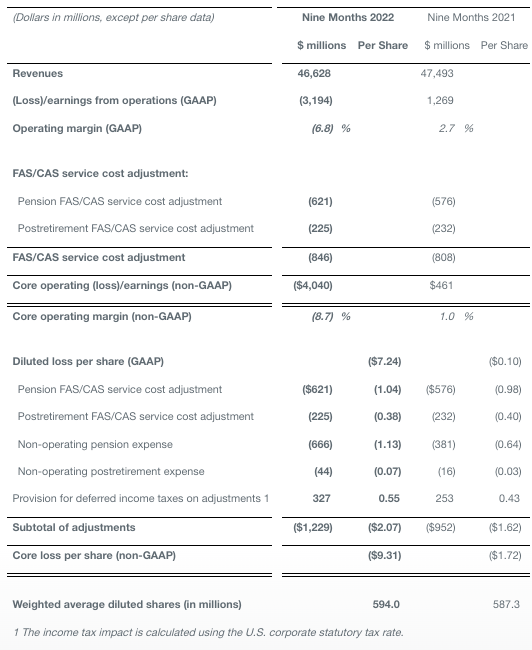Third Quarter 2022
- Operating cash flow of $3.2 billion; continue to expect positive free cash flow for 2022
- Resumed 787 deliveries and delivered 9 airplanes
- Recorded losses on fixed-price defense development programs
- Revenue of $16.0 billion; GAAP loss per share of ($5.49) and core (non-GAAP)* loss per share of ($6.18)Total backlog of $381 billion; including over 4,300 commercial airplanes
- Total backlog of $381 billion; including over 4,300 commercial airplanes

"We continue to make important strides in our turnaround and remain focused on our performance," said Dave Calhoun, Boeing President, and Chief Executive Officer. "We generated strong cash in the quarter and are on a solid path to achieving positive free cash flow for 2022. At the same time, revenue and earnings were significantly impacted by losses on our fixed-price defense development programs. We're squarely focused on maturing these programs, mitigating risks, and delivering for our customers and their important missions. We remain in a challenging environment and have more work ahead to drive stability, improve our performance and ensure we're consistently delivering on our commitments. Despite the challenges, I'm proud of our team and the progress we've made to strengthen our company."


Cash and investments in marketable securities increased to $14.3 billion, compared to $11.4 billion at the beginning of the quarter, primarily driven by cash from operations (Table 3). The company has access to credit facilities of $12.0 billion, which remain undrawn.
Segment Results
Commercial Airplanes

Commercial Airplane's third-quarter revenue increased to $6.3 billion, driven by the resumption of 787 deliveries and higher 737 deliveries (Table 4). The operating margin of (10.3) percent also reflects lower abnormal costs as compared to the third quarter of 2021, partially offset by higher period expenses, including R&D expenses.
The company also resumed 787 deliveries in late August, following comprehensive reviews to ensure each airplane meets the company's highest standards. The program is producing at a low rate with an expected gradual return to five per month over time.
Since late 2020, the 737 MAX fleet has completed nearly 1 million revenue flights. During the quarter, the company secured net orders for 227 aircraft, including 167 737 airplanes, 27 767 airplanes, 18 777 airplanes, and 15 787 airplanes. Commercial Airplanes delivered 112 airplanes during the quarter and the backlog included over 4,300 airplanes valued at $307 billion.
Defense, Space & Security

Defense, Space & Security third-quarter revenue decreased to $5.3 billion and third-quarter operating margin decreased to (52.7) percent, primarily due to $2.8 billion of losses on certain fixed-price development programs, driven by higher estimated manufacturing and supply chain costs, as well as technical challenges. These losses were recorded on the KC-46A, VC-25B, MQ-25, T-7A, and Commercial Crew programs. Results were also impacted by unfavorable performance on other programs.
During the quarter, Defense, Space & Security captured KC-46A Tanker awards from the U.S. Air Force for 15 aircraft and the Israeli Air Force for four aircraft, and Poland selected the AH-64E Apache as its future attack helicopter. Defense, Space & Security delivered 34 aircraft and two satellites, including the first four MH-139A Grey Wolf helicopters to the U.S. Air Force. Also during the quarter, Defense, Space, and Security opened the Advanced Composite Fabrication Center in Mesa, Arizona.
The backlog at Defense, Space & Security was $55 billion, of which 31 percent represents orders from customers outside the U.S.
Global Services

Global Services' third-quarter revenue increased to $4.4 billion and the third-quarter operating margin increased to 16.5 percent primarily driven by higher commercial services volume and favorable mix, partially offset by lower government services volume.
During the quarter, Global Services was awarded a follow-on KC-767A Performance Based Logistics support contract for the Italian Air Force and received a F/A-18 depot support order for the U.S. Navy. Global Services also signed a Landing Gear Exchange and Airplane Health Management agreement with Ethiopian Airlines. Also in the quarter, Global Services delivered the 100th contracted 737-800BCF to AerCap.
Additional Financial Information
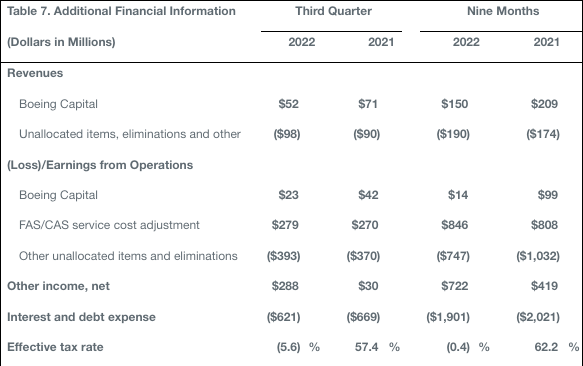
At quarter-end, Boeing Capital's net portfolio balance was $1.6 billion. The change in other income was driven by the absence of a pension settlement charge recorded in the third quarter of 2021. Interest and debt expense decreased due to a lower debt balance. The third quarter effective tax rate primarily reflects tax expense due to an increase in the valuation allowance.
Non-GAAP Measures Disclosures
We supplement the reporting of our financial information determined under Generally Accepted Accounting Principles in the United States of America (GAAP) with certain non-GAAP financial information. The non-GAAP financial information presented excludes certain significant items that may not be indicative of, or are unrelated to, results from our ongoing business operations. We believe that these non-GAAP measures provide investors with additional insight into the company's ongoing business performance. These non-GAAP measures should not be considered in isolation or as a substitute for the related GAAP measures, and other companies may define such measures differently. We encourage investors to review our financial statements and publicly-filed reports in their entirety and not rely on any single financial measure. The following definitions are provided:
Core Operating Earnings, Core Operating Margin, and Core Loss Per Share
Core operating earnings is defined as GAAP earnings from operations excluding the FAS/CAS service cost adjustment. The FAS/CAS service cost adjustment represents the difference between the Financial Accounting Standards (FAS) pension and postretirement service costs calculated under GAAP and costs allocated to the business segments. Core operating margin is defined as core operating earnings expressed as a percentage of revenue. Core (loss)/earnings per share is defined as GAAP diluted earnings per share excluding the net earnings per share impact of the FAS/CAS service cost adjustment and Non-operating pension and postretirement expenses. Non-operating pension and postretirement expenses represent the components of net periodic benefit costs other than service costs. Pension costs, comprising service and prior service costs computed in accordance with GAAP are allocated to Commercial Airplanes and BGS businesses supporting commercial customers. Pension costs allocated to BDS and BGS businesses supporting government customers are computed in accordance with U.S. Government Cost Accounting Standards (CAS), which employ different actuarial assumptions and accounting conventions than GAAP. CAS costs are allocable to government contracts. Other postretirement benefit costs are allocated to all business segments based on CAS, which is generally based on benefits paid. Management uses core operating earnings, core operating margin, and core earnings per share for purposes of evaluating and forecasting underlying business performance. Management believes these core earnings measures provide investors additional insights into operational performance as they exclude non-service pension and post-retirement costs, which primarily represent costs driven by market factors and costs not allocable to government contracts. A reconciliation between the GAAP and non-GAAP measures is provided on pages 12 & 13.
Free Cash Flow
Free cash flow is GAAP operating cash flow reduced by capital expenditures for property, plant, and equipment. Management believes free cash flow provides investors with an important perspective on the cash available for shareholders, debt repayment, and acquisitions after making the capital investments required to support ongoing business operations and long-term value creation. Free cash flow does not represent the residual cash flow available for discretionary expenditures as it excludes certain mandatory expenditures such as repayment of maturing debt. Management uses free cash flow as a measure to assess both business performance and overall liquidity. Table 2 provides a reconciliation of free cash flow to GAAP operating cash flow.
Caution Concerning Forward-Looking Statements
This press release contains "forward-looking statements" within the meaning of the Private Securities Litigation Reform Act of 1995. Words such as "may," "should," "expects," "intends," "projects," "plans," "believes," "estimates," "targets," "anticipates," and similar expressions generally identify these forward-looking statements. Examples of forward-looking statements include statements relating to our future financial condition and operating results, as well as any other statement that does not directly relate to any historical or current fact. Forward-looking statements are based on expectations and assumptions that we believe to be reasonable when made, but that may not prove to be accurate. These statements are not guarantees and are subject to risks, uncertainties, and changes in circumstances that are difficult to predict. Many factors could cause actual results to differ materially and adversely from these forward-looking statements. Among these factors are risks related to: (1) the COVID-19 pandemic and related industry impacts, including with respect to our operations, our liquidity, the health of our customers and suppliers, and future demand for our products and services; (2) the 737 MAX, including the timing and conditions of remaining 737 MAX regulatory approvals, lower than planned production rates and/or delivery rates, and additional considerations to customers and suppliers; (3) general conditions in the economy and our industry, including those due to regulatory changes; (4) our reliance on our commercial airline customers; (5) the overall health of our aircraft production system, planned commercial aircraft production rate changes, our commercial development and derivative aircraft programs, and our aircraft being subject to stringent performance and reliability standards; (6) changing budget and appropriation levels and acquisition priorities of the U.S. government; (7) our dependence on U.S. government contracts; (8) our reliance on fixed-price contracts; (9) our reliance on cost-type contracts; (10) uncertainties concerning contracts that include in-orbit incentive payments; (11) our dependence on our subcontractors and suppliers, as well as the availability of raw materials; (12) changes in accounting estimates; (13) changes in the competitive landscape in our markets; (14) our non-U.S. operations, including sales to non-U.S. customers; (15) threats to the security of our, our customers' and/or our suppliers' information; (16) potential adverse developments in new or pending litigation and/or government investigations; (17) customer and aircraft concentration in our customer financing portfolio; (18) changes in our ability to obtain debt financing on commercially reasonable terms and at competitive rates; (19) realizing the anticipated benefits of mergers, acquisitions, joint ventures/strategic alliances or divestitures; (20) the adequacy of our insurance coverage to cover significant risk exposures; (21) potential business disruptions, including those related to physical security threats, information technology or cyber-attacks, epidemics, sanctions or natural disasters; (22) work stoppages or other labor disruptions; (23) substantial pension and other postretirement benefit obligations; (24) potential environmental liabilities; and (25) effects of climate change and legal, regulatory or market responses to such change.
Additional information concerning these and other factors can be found in our filings with the Securities and Exchange Commission, including our most recent Annual Report on Form 10-K, Quarterly Reports on Form 10-Q and Current Reports on Form 8-K. Any forward-looking statement speaks only as of the date on which it is made, and we assume no obligation to update or revise any forward-looking statement, whether as a result of new information, future events, or otherwise, except as required by law.

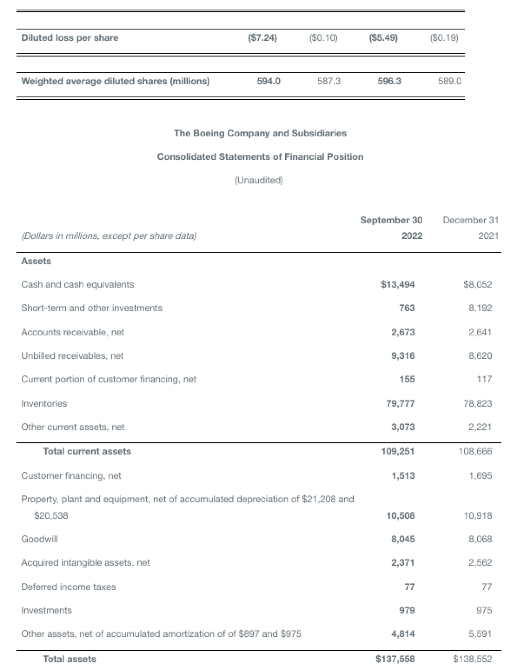
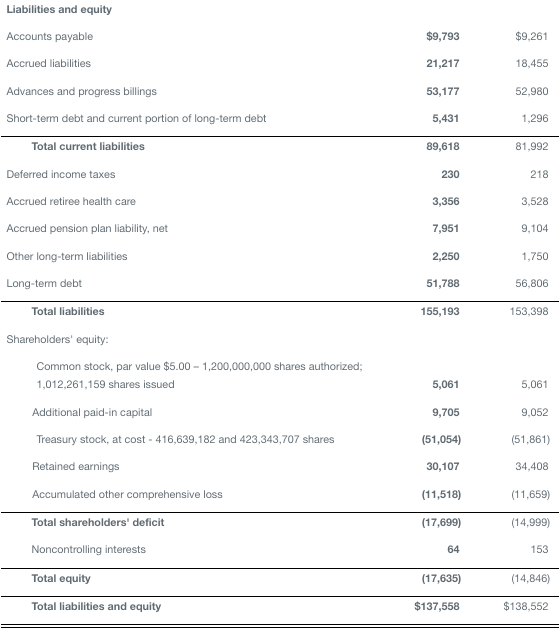
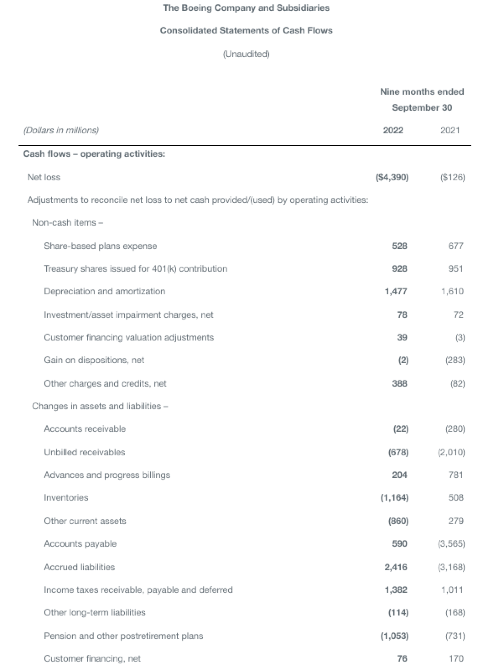
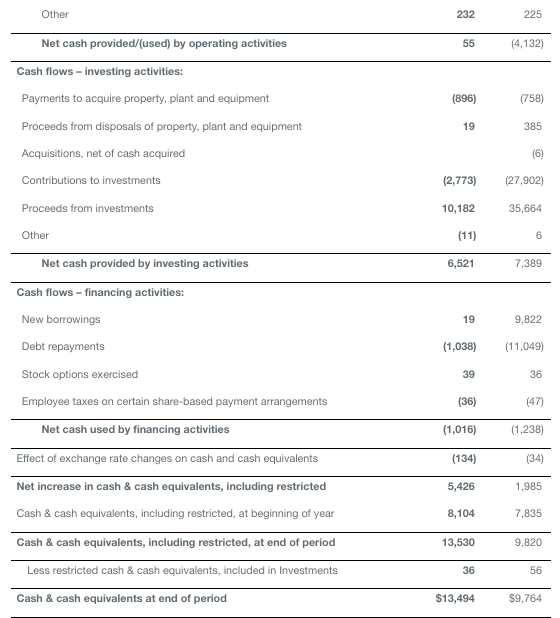
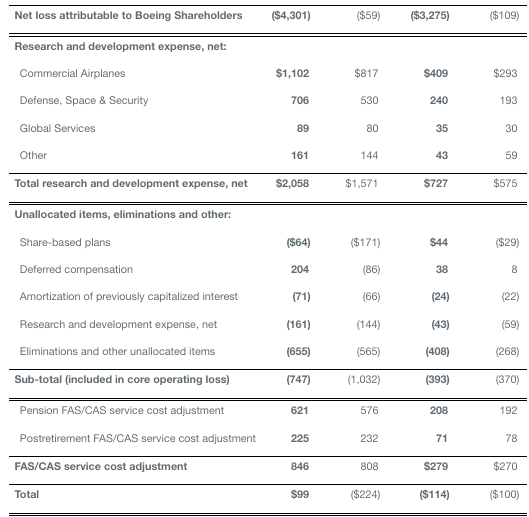
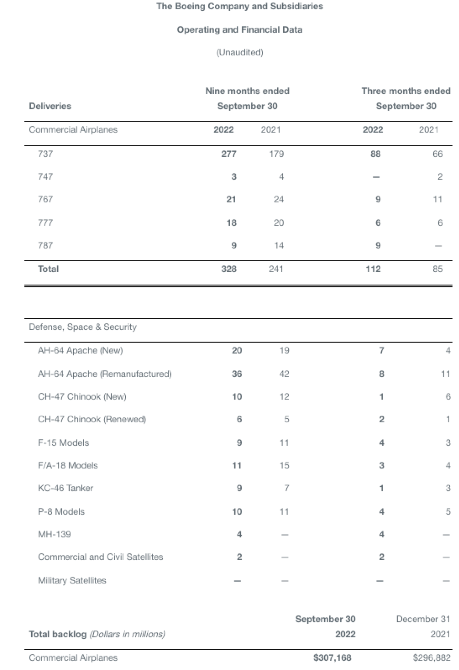

The Boeing Company and Subsidiaries Reconciliation of Non-GAAP Measures
(Unaudited)
The tables provided below reconcile the non-GAAP financial measures core operating (loss)/earnings, core operating margin, and core loss per share with the most directly comparable GAAP financial measures, (loss)/earnings from operations, operating margin, and diluted loss per share. See page 5 of this release for additional information on the use of these non-GAAP financial measures.

The Boeing Company and Subsidiaries Reconciliation of Non-GAAP Measures
(Unaudited)
The tables provided below reconcile the non-GAAP financial measures core operating (loss)/earnings, core operating margin, and core loss per share with the most directly comparable GAAP financial measures, (loss)/earnings from operations, operating margin, and diluted loss per share. See page 5 of this release for additional information on the use of these non-GAAP financial measures.
